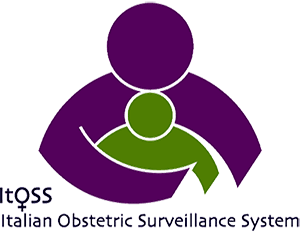General information
 The Italian Obstetric Surveillance System (ItOSS) collects and disseminates information on severe maternal morbidity and mortality. Since 2017, the surveillance system of maternal mortality, coordinated by the Istituto Superiore di Sanità (ISS), has been collecting comprehensive and reliable data on maternal mortality in 18 Italian regions (Valle D'Aosta, Piedmont, Liguria, Lombardy, Veneto, Friuli Venezia Giulia, Emilia-Romagna, Marche, Umbria, Tuscany, Lazio, Abruzzo, Campania, Puglia, Basilicata, Calabria, Sicily and Sardinia, the Autonomous Province of Trento and the Autonomous Province of Bolzano), accounting for 99% of total births in Italy in 2022. Between 2008 and 2016, through the National Centre for Disease Prevention and Control (Centro nazionale per la prevenzione e il controllo delle malattie – CCM), the Ministry of Health consistently funded a series of ISS-coordinated multiregional projects which allowed further development and consolidation of the surveillance.
The Italian Obstetric Surveillance System (ItOSS) collects and disseminates information on severe maternal morbidity and mortality. Since 2017, the surveillance system of maternal mortality, coordinated by the Istituto Superiore di Sanità (ISS), has been collecting comprehensive and reliable data on maternal mortality in 18 Italian regions (Valle D'Aosta, Piedmont, Liguria, Lombardy, Veneto, Friuli Venezia Giulia, Emilia-Romagna, Marche, Umbria, Tuscany, Lazio, Abruzzo, Campania, Puglia, Basilicata, Calabria, Sicily and Sardinia, the Autonomous Province of Trento and the Autonomous Province of Bolzano), accounting for 99% of total births in Italy in 2022. Between 2008 and 2016, through the National Centre for Disease Prevention and Control (Centro nazionale per la prevenzione e il controllo delle malattie – CCM), the Ministry of Health consistently funded a series of ISS-coordinated multiregional projects which allowed further development and consolidation of the surveillance.
Background
Maternal mortality in Europe decreased dramatically between 1930 and the 1980’s, before plateauing. Severe maternal morbidity and mortality during pregnancy, labour and childbirth have become increasingly rare in socially advanced countries, but cannot be considered a thing of the past and continue to be a public health priority.
In Italy, ItOSS estimated the maternal mortality ratio at 9 deaths per 100,000 live births, one of the lowest in Europe. In socially advanced countries, preventable maternal mortality is estimated at 50%. Preventing avoidable cases is the priority objective of ItOSS.
Scope of the obstetric surveillance
In light of the information derived from the analysis of reported events, ItOSS promotes actions for the dissemination of clinical practices that have been proved to be effective and safe at the regional and national levels. The ItOSS obstetric surveillance currently covers various areas of maternal and child health:
- The active surveillance of maternal mortality is based on a network of professionals from over 350 public and private healthcare facilities with obstetric, intensive care, coronary care and stroke units across the participating regions. Each maternal death is reported and, for each case, a multi-professional audit is performed at the facility where the death occurred and a confidential enquiry is carried out by a multi-professional committee appointed by the Regions. The results of the assessment are then shared with the ISS, which will carry out a further central verification before returning the information to the professionals. See the dedicated section.
- The Italian Perinatal Surveillance System (SPItOSS) is coordinated by the ISS in collaboration with 3 Italian regions (Lombardy, Tuscany and Sicily) and involves the reporting and in-depth analysis of late intrauterine deaths (at 28 weeks of gestation or more) and early neonatal deaths (live-born infants dying within the first week of life). See the dedicated section.
- The severe maternal morbidity research projects collect data on the most important severe maternal morbidity conditions for the purpose of improving their treatment and overcoming possible organizational problems identified along the clinical pathways. The projects involve public and private healthcare facilities with obstetric units across 9 regions (Lombardy, Piedmont, Friuli Venezia Giulia, Emilia Romagna, Tuscany, Lazio, Campania, Apulia, Sicily). See the dedicated section.
- The perinatal mental distress project focuses on women’s emotional state during pregnancy and after childbirth, and the early recognition of vulnerable parents by professionals in the maternity and primary care services. See the dedicated section.
- The maternal and perinatal sepsis project is part of the multicentre study promoted by the World Health Organization (WHO) in 58 countries for the purpose of: validating criteria for the identification of maternal sepsis, assessing the frequency and outcomes of maternal sepsis, and identifying good practices for prevention and management of maternal and neonatal sepsis. See the dedicated section.
- Development and updating of perinatal clinical guidelines in accordance with the National Guidelines System (Sistema Nazionale Linee Guida - SNLG) of the ISS. It is a key component of the ItOSS programme aimed at promoting clinical and organizational good practices in maternity care.
- International collaborations. In 2012, the Italian Obstetric Surveillance (ItOSS) joined the International Network of Obstetric Survey Systems (INOSS), which conducts population-based studies of low-prevalence severe maternal morbidity events. See the dedicated section (in Italian).
- Care in pregnancy, childbirth and the puerperium during the Covid-19
pandemic:
- The prospective population-based cohort study of Sars-Cov-2 infection in pregnancy and the puerperium, in which all Italian Regions and Autonomous Provinces are involved. The study aims to identify cases of maternal infection, describe their management and maternal and neonatal outcomes, and promptly present the relevant findings.
- A review of the literature on Covid-19 in pregnancy from the start of the pandemic, and the ISS report on COVID-19 provide a selection of useful resources to help healthcare workers implement appropriate clinical and care practices
The World Health Organization (WHO) designated ItOSS as the focal point for reviewing maternal mortality estimates in Italy.
